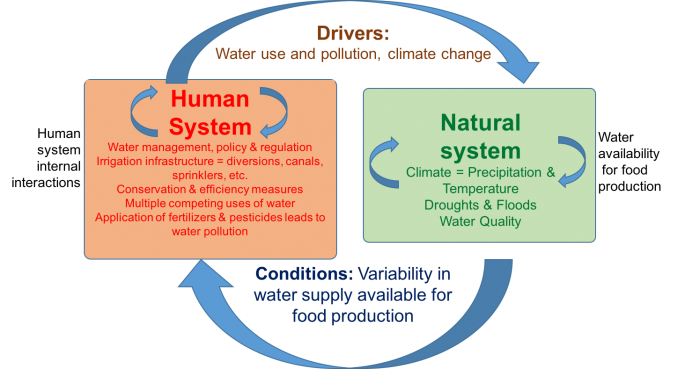Module 4 Summative Assessment (With Rubric)
Kansas Farm Case Study
Water is essential to growing food, and the source of water for food production is either naturally occurring precipitation or irrigation from surface or groundwater. The application of fertilizers and pesticides to crops results in the production of water pollution. We can incorporate water resources into our Coupled Human-Natural System diagram, where the climate of the natural system determines the availability of water for food production. The response in the human system is to develop irrigation systems where necessary and implement conservation and efficiency measures in time of scarcity. Also, application of fertilizers and pesticides results in water pollution, which impacts the water quality in the natural system.

Human/Natural System Diagram
Human System (Human System Internal Interactions)
- Water management, policy, and regulation
- Irrigation infrastructure = diversions, canals, sprinklers, etc.
- Conservation and efficiency measures
- Multiple competing users of water
- Application of fertilizers and pesticides leads to water pollution
*arrow pointing from human system to natural system: drivers: water use and pollution, climate change*
Natural System (Water availability for food production)
- Climate = precipitation and temperature
- Droughts and floods
- Water quality
*arrow pointing from natural system to human system: conditions: variability in water supply available for food production*
Instructions
In the summative assessment for Module 4, you'll apply what you've learned about coupled human and natural water systems to a particular farming scenario in Pawnee County, Kansas. You'll consider the precipitation in Kansas, the crops you could grow with that precipitation and then look at crop yields for different crops using irrigation. Finally, you'll consider the impact on water resources if you were to shift the types of crops grown and irrigation practices on a farm in Pawnee County, KS. The assignment is explained in the worksheet below.
- Download Module 4 Summative Assessment Worksheet:
- Download the Excel spreadsheet for calculations for Module 4 Summative Assessment
- The discussion portion of the worksheet is incorporated into the weekly discussion post.
Submitting your Assignment
After completing the worksheet, please complete the Module 4 Summative Assessment in Canvas.
Grading Information and Rubric
Your assignment will be evaluated based on the following rubric. The maximum grade for the assignment is 40 points.
| Criteria | Possible Points |
|---|---|
| Part 1: Precipitation | |
| Precipitation rates from map are correct | 2 |
| Part 2: Crops | |
| List of crops correctly represents crops that could be grown with natural precipitation | 4 |
| Part 3: Irrigation Efficiency and Crop Yield | |
| Scenario table correctly populated with results from the Crop Water Allocator | 14 |
| Part 4: Discussion and Synthesis | |
| Includes correct usage of the concept of water footprints and connection between diet and water consumption. | 5 |
| Clearly explains connections between farming, water scarcity, dead zones, and irrigation efficiency. Also demonstrates clearly the connection between increased water consumption and impacts to water resources, including quality and quantity impacts, such as nutrient pollution and groundwater depletions. | 10 |
| Well-written, proper spelling and grammar, and uses complete and well-crafted sentences. | 2 |
| Logical presentation of topics. Reasonable length. | 3 |
| TOTAL | 40 |
